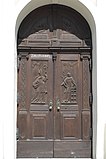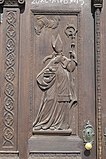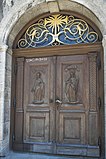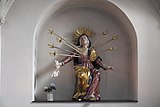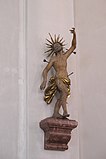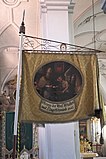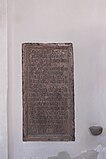St. Jakob (Dachau)
The Catholic parish church of St. Jakob in Dachau in the Upper Bavarian district of the same name is a late renaissance building that was built towards the end of the 16th and beginning of the 17th century on the site of a Romanesque predecessor church. The church, at the crossroads of three highways to Augsburg , Freising and Munich, is dedicated to the Apostle James the Elder , the patron saint of pilgrims and travelers.
history
A first church was probably built in the middle of the 13th century. The parish of Dachau is mentioned in writing for the first time in the Konradinische Matrikel , the list of goods of the diocese of Freising created in 1315/16 . In a document from 1390, the Dachau church is named with the patronage of St. James.
Towards the end of the 15th century, the north tower, which is still preserved today, was built. Between 1584 and 1586 the choir and tower were rebuilt under the direction of the Munich court architect Friedrich Sustris , whose most important works include the Jesuit Church of St. Michael in Munich. According to the plans of his son-in-law and successor Hans Krumpper , the old nave was replaced by a new building between 1624 and 1626 . In 1629 the burial chapel for Wilhelm Jocher and his wife was built on the south side of the choir . From 1774 the chapel was called the Holy Blood Chapel, and in 1933 it was converted into a sacristy .
In 1678 the late Gothic tower was raised and provided with an onion hood and lantern . Its basement is now used as an altar server. In 1926/27 the church was extended by two bays to the west and the new west facade with a large outside staircase was built.
location
The parish church of St. Jakob is centrally located in the upper old town of Dachau below the Dachau Castle . It is the reference point for all distances to and from Dachau. It is located at 506 m above sea level. NHN .
Exterior construction
Bell tower
In the northern corner of the choir rises the 44-meter-high tower, the octagonal bell-shaped storey of which has a filigree structure of rods and tracery .
sundial
In addition to the south portal, the large-scale sundial with the zodiac signs of the Dachau painter and later mayor Johann Georg Hörmann from 1699 covers the outer wall.
Portals
The entrance on the south side, above which the wooden figure of the church patron as a pilgrim of St. James is set in a niche , was the original main portal until the church was extended. On the right of the door leaves St. Laurentius with his attribute , the rust, is depicted, and on the left St. Nicholas with the three golden balls that he gave to three young women to save them from prostitution. The door wings of the north portal depict Jakobus on the left and perhaps a Bavarian duke or the Roman martyr Kastulus on the right, who according to legend was buried alive, as his shovel refers to. The reliefs of the two portals date from 1625. The west portal was created in the course of the extension of the church in 1927. The carved reliefs show St. Elisabeth of Thuringia with roses in her hands and St. Agnes of Rome with her attribute, the lamb.
inner space
The nave is a three-aisled pillar hall with five bays . The side aisles span transverse barrels with stab caps, the wider central nave is covered by a flat ribbed vault supported by cross-shaped pillars. The retracted, rectangular closed choir is illuminated by large arched windows like the nave. The entire interior is in the vault with a simple frame stucco from heart leaves and egg and dart coated.
Furnishing
- The current high altar was built in 1939. The tabernacle in the Rococo style dates back to the 18th century. The altar sheet taken from the previous altar depicts the Apostle James the Elder on the way to his beheading. It was painted in 1816 by Joseph Hauber (1766–1834).
- The two high baroque side altars, on the left the St. Mary's altar, on the right the Joseph's altar, from 1714, are made of stucco marble . The altar leaves in the Nazarene style were created in 1853 by the painter Franz Josef Wurm (1816–1865).
- The octagonal baptismal font made of red marble dates from the late Gothic period. The baroque group of figures of the baptism of Jesus from 1675 on the lid is attributed to Adam Luidl .
- The silver-chased half-length figure of the Apostle James from 1696 is the work of the Munich goldsmith Johann Georg Oxner. James is shown with a book in hand, a scallop shell, a pilgrim's staff and a bag.
- The silver traffic light above the altar table was created in 1704 by the Augsburg goldsmith Johann Joachim Lutz. St. James, Mary and the Dachau lap can be seen on it.
- The large crucifix and the Mater dolorosa pierced by a sword in the chancel are dated to the 18th century.
- The life-size, white-framed figures of the twelve apostles are placed on the pillars of the nave and in the choir. They are dated around 1625 and were possibly carved by Constantin Pader (around 1600–1681), who was based in Dachau at the time.
- The baroque carved figure of Saint Sebastian pierced by arrows next to the south entrance is reminiscent of the Sebastian Brotherhood .
- The late Gothic crucifixion group above the south portal was created between 1562 and 1567 by Adam Krumpper, Hans Krumpper's father. It was originally commissioned by Duke Albrecht V for the Dachau Palace Chapel.
- The figure of the painful Mother of God from around 1740 under the gallery is pierced by seven swords.
- Further figures from the Baroque period are an instruction from Mary (around 1700), a saint Florian (around 1630) and saint Rasso .
- The organ dates from 1997 and was built by the organ building company Vleugels .
Association flags of the craftsmen
The flags of the craftsmen's associations are put up in the church on special occasions. The flags were made in the 19th century and represent the patron saints of the respective craft trades. Saint Catherine of Alexandria is depicted on the flag of the millers and Melber (flour traders) as well as on the flag of the Wagner and tin caster. St. Eligius is depicted on the flag of the gun and nail smiths , on the flag of the shoemaker you can see the brothers Crispinus and Crispinianus .
Epitaphs and memorial stones
There are several epitaphs on the inner walls of the church . The epitaph of the ducal Kastner Georg Schwanckhler († 1606) shows the deceased with his family under the crucifix kneeling. A double coat of arms held by angels is depicted on the grave monument of the electoral castle keeper Wilhelm Jocher († 1636). A white marble bust is reminiscent of the beer brewer Josef Benedikt Butterer († 1801).
A red marble stone from 1627 contains a text on the building history and reports on the demolition of the old church and the start of construction on the new nave in 1624.
literature
- Handbook of German Art Monuments . Bayern IV - Munich and Upper Bavaria . 2nd edition, Deutscher Kunstverlag, Munich 2002, ISBN 3-422-03010-7 , p. 173 f.
- Lothar Altmann: Dachau. Catholic parish church of St. Jacob . (= Little Art Guide No. 459). 3rd completely revised edition, Verlag Schnell and Steiner, Regensburg 2010, ISBN 978-3-7954-6856-9
Web links
- Stadtpfarrkirche St. Jakob in Dachau Churches and chapels in the Dachauer Land (accessed June 21, 2017)
Coordinates: 48 ° 15 '34.7 " N , 11 ° 26' 4.1" E



